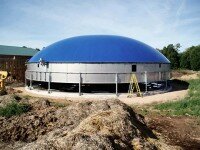Renewable heat
Posted in Technology on 05/21/2009 10:08 am by Stephen Tindale People often use the word ‘energy’ when they actually mean electricity. Only 20% of EU energy consumption is electricity (although this will rise as transport becomes increasingly electric.). The rest is for heat and for transport and, therefore, it is essential to expand renewable heat very substantially. This doesn’t mean neglecting renewable electricity and transport fuel, but it does mean a determined focus on heat.
People often use the word ‘energy’ when they actually mean electricity. Only 20% of EU energy consumption is electricity (although this will rise as transport becomes increasingly electric.). The rest is for heat and for transport and, therefore, it is essential to expand renewable heat very substantially. This doesn’t mean neglecting renewable electricity and transport fuel, but it does mean a determined focus on heat.
Renewable gas, usually referred to as ‘biogas’, can be fed into the gas grid, mixed with natural gas and used in exactly the same way. Biogas is already being injected into the gas grid in the US, France, Germany and Austria.
The most established way to produce biogas is by means of an anaerobic digester (AD). Using an AD involves putting organic waste (sewage, manure, food waste and so on) into a container, where it is kept without oxygen at a high temperature (around 40oC) and becomes a mixture of gas and solid compost. AD is currently used in many sewage works and some waste treatment plants, though the biogas, absurdly, is often flared. The compost, if it is made from waste or animal manure, can be used on fields or gardens and is an excellent fertiliser. If based on human sewage, there is no practical reason why it cannot be used as fertiliser, but public opposition would be strong (even though human sewage has always been used as manure and is still widely used in the developing world). Therefore, the solid compost from sewage AD could be incinerated (to generate electricity) or buried. Burying it would have the added advantage that the remaining greenhouse gases are then kept out of the atmosphere, making the biogas from AD not just ‘climate neutral’ but ‘climate positive’, part of a geo-engineering approach to reduce greenhouse gasses in the atmosphere.
A less developed technology for producing biogas is ‘gasification’, which is better suited to drier wastes and energy crops. Gasification technology was used to turn coal into gas up to the 1970s, but has not been used significantly since then. There are demonstration plants to turn organic waste in gas and energy crops being grown in Germany, Austria and the UK.
As it uses the existing gas grid, biogas significantly reduces the infrastructure cost of renewables development, and the EU has other Directives on reducing waste going to landfill and on improving water quality. A major expansion of biogas would help meet these Directives, so the additional costs of complying with the Renewables Directive would be very significantly reduced. For example, the UK National Grid company has estimated that biogas could meet 10% of total UK energy demand by 2020 (two thirds of the UK share of the renewables target). This would cost £30 billion. However, £20 billion of this is on new waste infrastructure (which needs to be built anyway), so the net cost is £10 billion.

